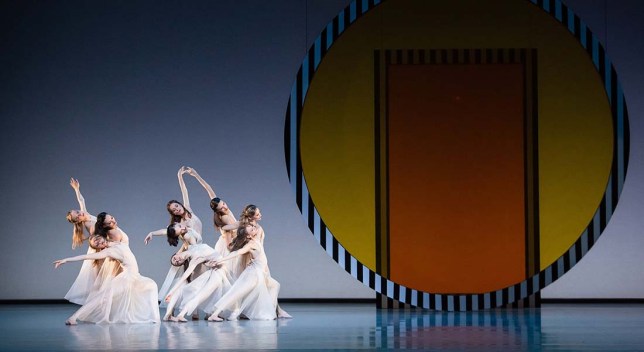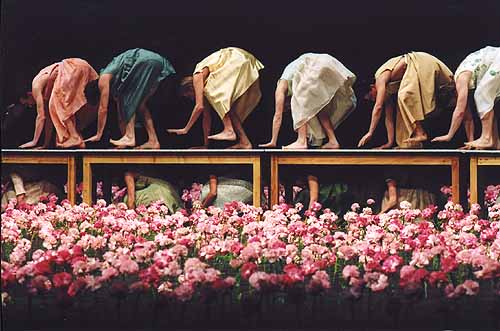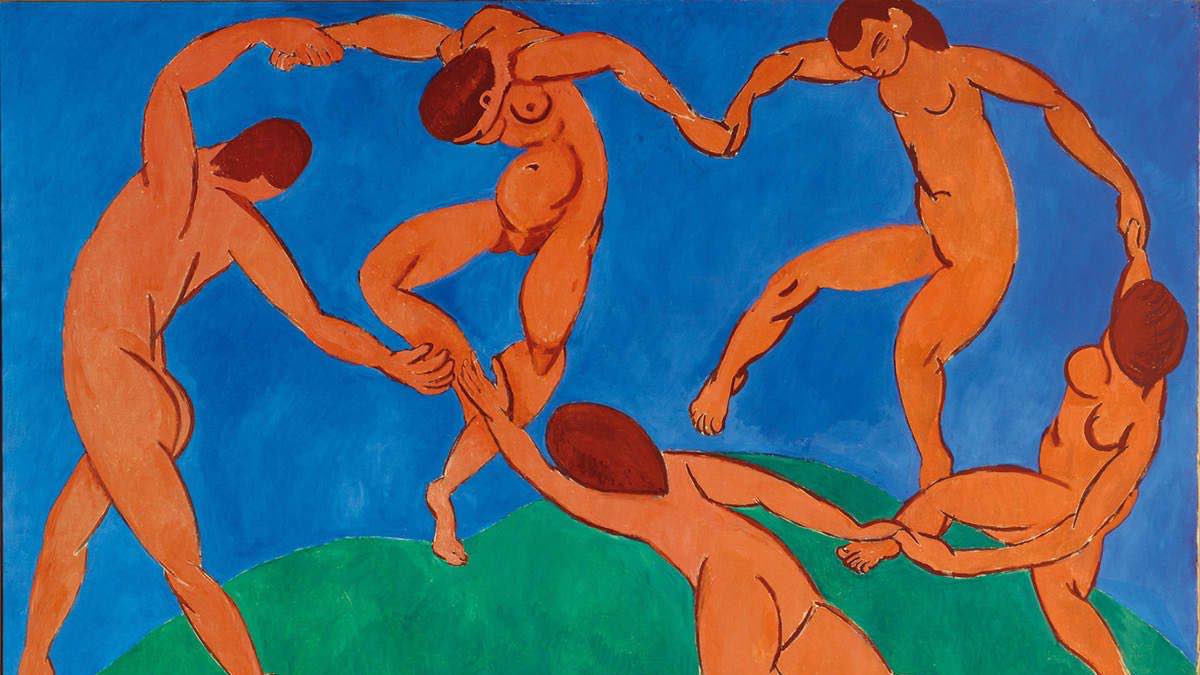
10 ballets at the boundary of dance and visual arts
The time for the great return of the total work of art has arrived! When visual artists decide to leave their prints on the body of dancers, it results in a melting pot as suave as a painting in motion. They create ballet paintings or ballets at the crossroads of a visual and sound work of art. Architecture, movement, gesture, space, and perspective, create a link between dance and visual arts. Artsper has made a short tour of the ballets that marry two pioneering arts of the modern revolution.
1. “Tree of Code”- Olafur Eliasson, Wayne McGregor, Jamie XX

Extract
After the successful collaboration between James Blake and William Forsythe at the Garnier Opera, the electro-pop ballet duo started experimenting again. This time, with Jamie XX, musician of the group XX, and Wayne McGregor, British choreographer. Converting the scenography into a vertiginous kaleidoscope is the work of Olafur Eliasson, a Danish visual artist. Eliasson created a titillation of perceptions. Seen in his interstellar spaces at the Vuitton Foundation, the Tate Modern, and in his Promethean Fountain in the gardens of the Palace of Versailles.
2. “Daphnis et Chloé” – Daniel Buren, Benjamin Millepied, Maurice Ravel

Composed for a Russian ballet company, the premiere of Daphnis and Chloe, was held on June 8th, 1912, at the Chatelet Theater under the direction of Pierre Monteux (choreography by: Michel Fokine, costumes. Extract.
From the tandem of Daniel Buren and Benjamin Millepied is a ballet of bodies and objects. Daphnis and Chloe, an experimental piece shown at the Bastille Opera. The first adopted his usual “graphic” scenario set against a striped curtain. The second incorporated air mobility. It told the love story of two shepherds. Lastly, the third reveals “Ravel” and discloses the face of elation.
3. “Rain Forest” – Andy Warhol, Merce Cunningham, David Tudor

The process of serialization, the elements of popular culture, and the hybridization between art and life, were transferred from the Warholian piece to the Ballet of Merce Cunningham, done in 1968. With minimal music and postmodern dance, the choreography of RainForest reflects the encounter of arts, specific of the creation of the 60s in New York. The Silver Clouds by Andy Warhol, are part of the body of the ballet, as it is the electronic music by David Tudor, a disciple of John Cage.

Influenced by John Cage and his sporatic compositions, Merce Cunningham frees dance from the confines of rhythm. Admiring the freedom infused by Merce Cunningham in his ballets, the visual artists that created the decoration of his sets. Drawing upon artistic inspiration, ranging from Marcel Duchamp and Bruce Nauman to Ernesto Neto.
“Dance gives you nothing in return, no manuscript to sell, no paint to put on the walls, no poem to print, nothing but the unique sensation of feeling alive” – Merce Cunningham.
4. “Danser la peinture” – James Turrel, Mélanie Perrier

on the right : Mélanie Perrier/James Turrel, Danser la peinture, Nouvelles Editions Scala, 2015 © Mélanie Perrier
To dance within the work of art is the challenge that photographer Laurent Paillier and dance critic Philippe Verrièle gave to 11 young choreographers. Seven years after the cosmic spaces of James Turrell, Mélanie Perrier grasped his baths of light as the perfect setting for the dance piece. Contemplative and immersive.
5. “Le Bal Bullier” – Loïe Fuller, Sonia Delaunay

On the right : Sonia Delaunay, Le Bal Bullier, 1913, Oil on canvas matelas, 97 x 390 cm © Collection of Modern Art at the Centre Pompidou, Paris, France.
“Gently-almost religiously- I set the silk in motion, and I saw that I had obtained undulations of a character heretofore unknown. I had created a new dance!” Loie Fuller, My life and Dance 1908.
There are two figures of dance who have revolutionized the conception of codified art, Isadora Duncan, the barefoot dancer or “l’art de danser sa vie”, and Loie Fuller, pioneer of avant-garde aesthetics, in kinetic ballets, where light, color and movement make echo. Video demonstration.
6. Michael Clark Company – Tate Modern

Ordered by Barbican, Michael Clark Company (Clark born 1962, company founded 1984), Tate Live: Michael Clark Company at Tate Modern 2010-2011, Turbine Hall Residency 2010, th 2011.
In response to the monumental architecture of the Turbine Hall, Michael Clark, an artist associated with the Barbican of London, experimented with a choreography where the dancers and the decoration are closely connected. With a formal aesthetics, in the style of Buren, the ballet plays with the codes of (contemporary and classical) dance under the influence of the pop-rock-punk culture with a style close to Bowie’s. A collaborative work between Charles Atlas and Stevie Stewart, combining formal grace at the cutting edge of transgression. You can see the proof on these exquisite 2 minutes.
7. “Les œillets de l’espoir” – Pina Baush, Peter Pabst

After a discussion between Peter Pabst and Pina Bausch about the beauty of the Tulip fields in Holland, éclos Nelken or the Carnations of Hope in English, was choreographed by the German artist and staged by his acolyte in 2015. The aestheticism of Pina consist on a pictorial canvas where the influences of European culture proliferate, after the traces of the Greek tragedy and the expressionist tendency, where the shadows of Pasolini, Stravinsky, Perrault are present…
8. « Signes » – Olivier Debré, Carolyn Carlson, René Aubry

With the musical participation of Rene Aubry, the dancers from the Opera of Paris, take part in a pictorial set done by Olivier Debré. With Signs, American choreographer, Carolyn Carlson did a graphic gesture, like with a brush, where lyricism invites to purity.
9. “Rain“ – Ann Teresa de Keersmaeker, Steive Rech

Resembling the spring paintings of Claude Monet after going through minimal art, Rain, created by Ann Teresa Keersmaeker, mixed a saturated palette of pink with aerial undulations on the walls of the Garnier Opera in 2014. The hypnotic music by Steve Reich overturns the refreshing character with a highlighted tension. The exacerbated paradoxes lead to a disturbing feeling of strangeness, that of the beauty of the sublime. Demonstration of the elation, in images.
10. “Pixel” – Compagnie Käfig, Adrien Mondot et Claire Bardainne
© CCN Créteil et Val-de-Marne / Compagnie Kafig
A dance of hypnotic images and unrestrained music. Pixel is a combination of digital art, hip hop dance, and classical music. Mourad Merzouki, the alchemist of dance and pixels, created a fairytale with 11 dancers from the Kafig Company. He also also worked with a duo of ingenious engineers.

About Artsper
Founded in 2013, Artsper is an online marketplace for contemporary art. Partnering with 1,800 professional art galleries around the world, it makes discovering and acquiring art accessible to all.
Learn more













